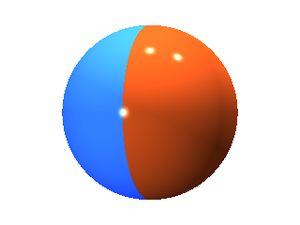Janus particles

Janus particles are particles consisting of (at least) two parts with different interactions. For example, the typical Janus particle is a sphere which has a short-range attraction on one half of the particle, but is purely repulsive on the other side. However, the term has also been used for non-spherical particles. The name derives from the two-faced Roman god Janus. Janus particles can be considered as a one-patch patchy particle.
Experimentally, the different interactions can be achieved by (for example) making the two parts of the surface hydrophobic and hydrophilic, positively and negatively charged, or smooth and rough (leading to different interactions in the presence of depletants). In simulations, these particles are often modeled using the Kern-Frenkel interaction potential.
Phase diagram
See also
References
- Related reading
- Steve Granick, Shan Jiang, and Qian Chen "Janus particles", Physics Today 62 pp. 68-69 (July 2009)
- Gerald Rosenthal, Keith E. Gubbins, and Sabine H. L. Klapp "Self-assembly of model amphiphilic Janus particles", Journal of Chemical Physics 136 174901 (2012)
- Miguel Ángel G. Maestre, Riccardo Fantoni, Achille Giacometti, and Andrés Santos "Janus fluid with fixed patch orientations: Theory and simulations", Journal of Chemical Physics 138 094904 (2013)